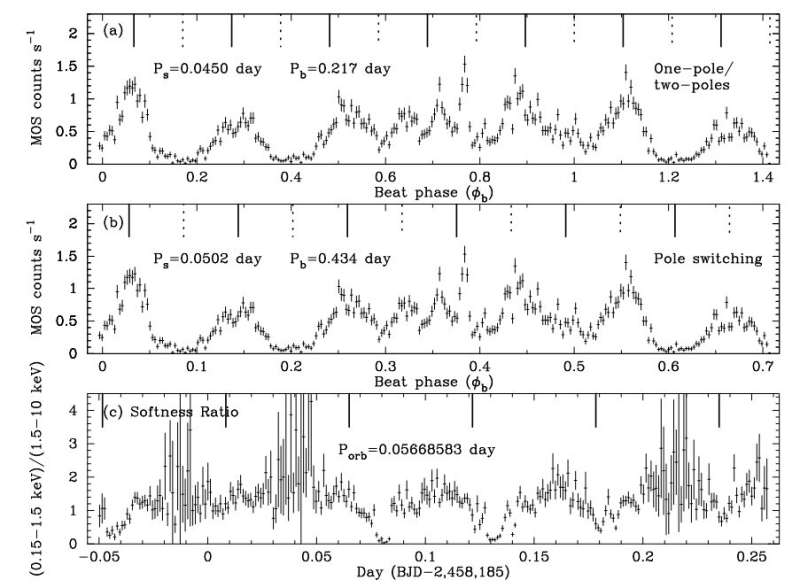July 11, 2022 report
Astronomers investigate a peculiar cataclysmic variable

Using ESA's XMM-Newton satellite, astronomers from the Columbia University in New York have inspected a peculiar cataclysmic variable system known as Swift J0503.7−2819. Results of the study, presented June 29 on arXiv.org, provide important hints regarding the properties and nature of this variable.
Cataclysmic variables (CVs) are binary star systems consisting of a white dwarf accreting material from a normal star companion. They irregularly increase in brightness by a large factor, then drop back down to a quiescent state. Polars are a subclass of cataclysmic variables distinguished from other CVs by the presence of a very strong magnetic field in their white dwarfs.
In some CVs, accretion occurs through a truncated accretion disk when the white dwarf is moderately magnetic. These systems are known as intermediate polars (IPs). Observations have shown that in IPs, the magnetic white dwarf (WD) spins asynchronously with the orbital period of the system and therefore produces a rapid oscillation with the spin period. Therefore, determining precise spin period and precise oscillation ephemeris could be the key to revealing the IP nature of some CVs.
Located some 2,730 light years away, Swift J0503.7−2819 is a CV initially classified as an intermediate polar with an orbital period of about 0.0567 days. It has an X-ray luminosity at a level of approximately 360 nonillion erg/s.
Recently, a team of astronomers led by Jules P. Halpern has analyzed the XMM-Newton light curve of Swift J0503.7−2819, hoping to gain more insights into its properties.
"Swift J0503.7−2819 was observed by XMM-Newton on 2018 March 7 (ObsID 0801780301) for 7.4 hr. We used the processed event files from the two EPIC MOS cameras and the EPIC pn cameras to create X-ray light curves," the researchers explained.
First, Halpern's team identified candidates for the spin frequency of Swift J0503.7−2819 that are either 24 or 12 percent faster than the orbital frequency determined optically. Then they refined their values using photometric data from NASA's Transiting Exoplanet Survey Satellite (TESS) and Asteroid Terrestrial-impact Last Alert System (ATLAS) survey.
The researchers found that either value of the frequency excess is characteristic of a small class of highly asynchronous polars (APs) or stream-fed IPs. They explained that such behavior of the light curve can be described by either of these two scenarios: one that switches between one-pole and two-pole accretion, and another in which accretion alternates fully between two poles.
The astronomers noted that the spin periods of Swift J0503.7−2819 in these two models (AP and IP) are 0.0455 days and 0.0505 days, respectively. They added that the corresponding beat period between spin and orbit was found to be 0.231 days and 0.462 days, respectively.
In conclusion, the researchers suggest further X-ray observations of Swift J0503.7−2819 are needed in order to determine whether this CV is an AP or an IP.
"This should reveal whether a different pole is alternating in accretion with the first, through inevitable differences in viewing geometry, obscuration, or size," they state.
More information: J. P. Halpern, Swift J0503.7−2819: A Short-Period Asynchronous Polar or Stream-Fed Intermediate Polar. arXiv:2206.14770v1 [astro-ph.HE], arxiv.org/abs/2206.14770
© 2022 Science X Network





















